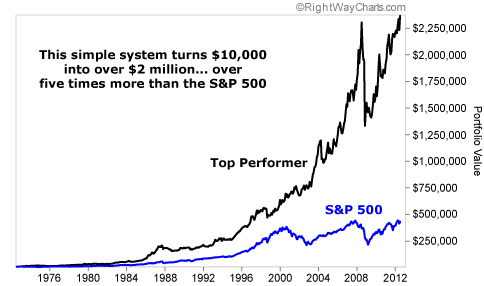 I want to share with you an incredibly simple strategy today… one that has consistently crushed the markets.
I want to share with you an incredibly simple strategy today… one that has consistently crushed the markets.
It has worked for decades.
It has delivered higher returns than the stock market – more importantly, with less risk than the stock market (less volatility).
It’s nothing weird or bizarre.
[ad#Google Adsense 336×280-IA]It’s a simple idea.
And the results seem too good to be true… but they are true.
The system is simple: Buy what’s working.
It turned $10,000 into $573 million over the last nine decades.
And it will keep compounding wealth, both in individual stocks and among asset classes, for decades to come.
This simple system will continue to work because most people can’t bring themselves to follow it.
It’s like they have a mental block. This common mental block is a great thing for the rest of us… It will allow this simple system to keep working – and the more that people don’t believe it, the longer it will work!
Here’s the mental block: Most people are afraid to buy what has gone up. Instead, most people prefer to buy what is down.
If Apple stock is up and hitting new highs, for example, people are afraid to buy more Apple. Instead, they like to bet on the longshot – the maker of Blackberry (RIMM). But as I showed you in April, Apple keeps going up. And RIMM keeps going down.
It’s not just with Apple and Blackberry… it works with all stocks.
In his book What Works on Wall Street, James O’Shaughnessy studied the numbers going back to 1925. The results are just incredible…
If you bought the worst-performing 10% of stocks over the previous six months, you would have outperformed the market just once since the end of World War II. After the great bust in 2008, the worst performers briefly turned into the best performers when the market recovered… But that was the only time it happened.
The story is crazy-different when you look at the best performers instead…
Starting in 1925, you would have turned $10,000 into $573 million simply by buying the best-performing 10% of stocks over the previous six months, holding, and rebalancing monthly.
The message from history is painfully obvious… Buy the winners and don’t buy the losers. Buy the Apples, not the Blackberrys.
The thing is, most of us can’t figure out how to buy the top 10% of best-performing stocks. But this same idea works with whole asset classes, too…
Buy the best-performing asset class over the previous six months. Wait one month, and then buy the new best-performing asset class over the previous six months.
I ran the numbers going back 40 years. I looked at five asset classes (U.S. stocks, foreign stocks, REITs, commodities, and bonds). By simply buying the best-performing asset class over the preceding six months, you’d have outperformed the stock market by nearly 50% a year over the last 40 years. (Specifically, stocks returned 9.9% annualized. This simple system returned 14.6%.)
Over time, the outperformance is enormous… turning $10,000 into over $2 million versus just $400,000 for the S&P 500 alone.

My friend Mebane Faber (www.MebaneFaber.com) has studied this type of thing closely – and he suggests buying the top-TWO-performing asset classes, instead of just the top one. Based on history, that is a GREAT idea…
Over the last 40 years, buying the top two asset classes STILL beats the stock market (12.6% to 9.9%). But importantly, it reduces your risk (the volatility). Only boring Treasury bonds have less volatility than simply buying the top two asset classes over the preceding six months.
This strategy easily beats the market with MUCH less volatility. And I expect the outperformance for decades to come.
To beat the market safely and simply, stick with what’s been working in recent months…
This strategy would have turned $10,000 into $572 million in stocks… It works in asset classes as well… And most importantly, there’s no reason for that outperformance to go away.
The “system” really is simple. Stick with what’s working. Buy what’s done well over the last six months. Based on history, chances are great you’ll outperform the markets…
Good investing,
Steve
[ad#jack p.s.]
Source: Daily Wealth
